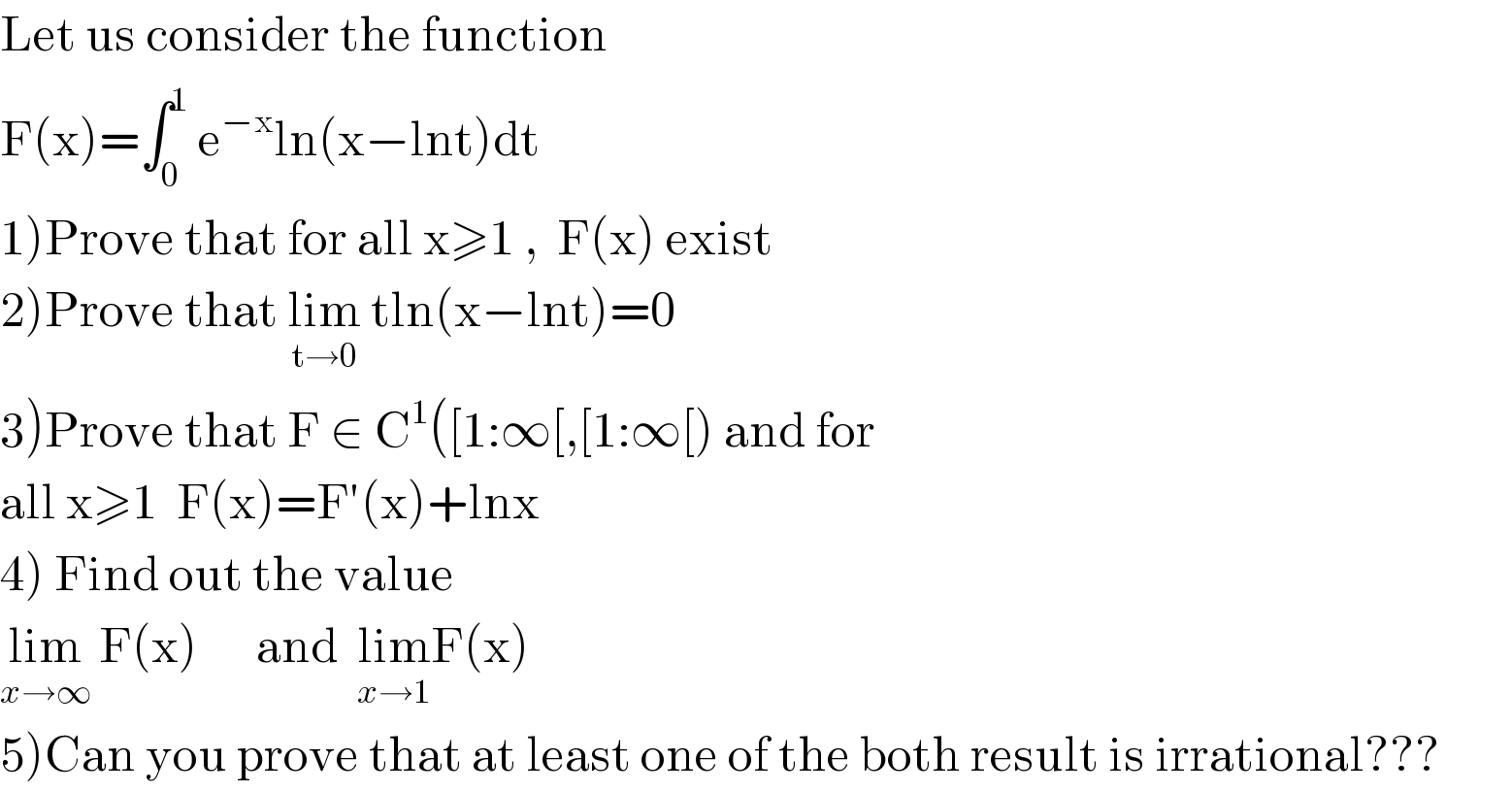Question Number 75220 by ~blr237~ last updated on 08/Dec/19

Answered by mind is power last updated on 08/Dec/19
![mistak at 3) F(x)=∫_0 ^1 e^(−x) ln(x−ln(t))dt F′(x)=∫_0 ^1 {−e^(−x) ln(x−ln(t))+(e^(−x) /(x−ln(t)))}dt by part F(x)=e^(−x) ∫_0 ^1 1.ln(x−ln(t))dt F(x)=e^(−x) {[tln(x−ln(t))]_0 ^1 −∫_0 ^1 t.((−1)/t).(dt/(x−ln(t)))} =e^(−x) ln(x)+e^(−x) ∫_0 ^1 (dt/(x−ln(t))) ⇒F(x)−F′(x)=∫_0 ^1 e^(−x) ln(x−ln(t))dt+e^(−x) ln(x) ⇔−F′(x)=e^(−x) ln(x) ⇒F′(x)=−e^(−x) ln(x)](https://www.tinkutara.com/question/Q75234.png)
Commented by ~blr237~ last updated on 08/Dec/19

Commented by mind is power last updated on 08/Dec/19

Commented by ~blr237~ last updated on 09/Dec/19

Answered by mind is power last updated on 09/Dec/19
![F(x )=∫_0 ^1 e^(−x) ln(x−ln(t))dt uf x≥1⇒x−ln(t)≥1 ,∀t∈[0,1] 1≤ln(x−ln(t))=ln(x)+ln(1−((ln(t))/x))≤ln(x)−((ln(t))/x)≤ln(x) 0≤∫_0 ^1 e^(−x) ln(x−ln(t))dt≤e^(−x) ∫_0 ^1 (ln(x)−((ln(t))/x))dt=(ln(x)+(1/x))e^(−x) ⇒F(x) exist 2) ∀(x,t)∈[1,+∞[×[0,1] 0≤tln(x−ln(t))≤t ln(x)−((tln(t))/x) lim tln(x)−((tln(t))/x)→0 ⇒t ln(x−ln(t))→0 3) F is C_1 F is continous (x,t)→e^(−x) ln(x−ln(t)) is continous in each variable e^(−x) ln(x−ln(t))≤e^(−x) {ln(x)+ln(1−((ln(t))/x))}≤e^(−x) {ln(x)−((ln(t))/x)} ≤e^(−x) ln(x)+(e^(−x) /x){−ln(t)} e^(−x) ln(x)≤1,∀x≥1 (e^(−x) /x)≤1 ,∀x≥1⇒e^(−x) ln(x−ln(t))≤1−ln(t)=g(t) ⇒e^(−x) ln(x−ln(t))≤(1−ln(t))=g(t) witch is integrBl in ]0,1[ (t,x)→(∂/∂x)(e^(−x) ln(x−ln(t))) continus (t,x)→(∂/∂t)(e^(−x) ln(x−ln(t)))continus over [0,1[ (∂/∂x)(e^(−x) ln(x−ln(t)))=−e^(−x) ln(x−ln(t))+(e^(−x) /(x−ln(t))) x−ln(t)≥1⇒(e^(−x) /(x−ln(t)))≤e^(−x) ≤1 ln(x−ln(t))=ln(x)+ln(1−((ln(t))/x))≤ln(x)−((ln(t))/x) ⇒∣(∂/∂x)(e^(−x) ln(x−ln(t)))∣≤e^(−x) ln(x−ln(t))+1≤e^(−x) ln(x)+e^(−x) .((−ln(t))/x)+1 ≤3−ln(t) =g(t) ⇒∀x∈[1,+∞[ ∫∣(∂/∂x)(e^(−x) ln(x−ln(t))∣dt≤∫_0 ^1 g(t)dt=4 ⇒F(x) is C_1 g(x)=e^x F(x) g(x) is C_1 since F(x) and e^x are g(x)=∫_0 ^1 ln(x−ln(t))dt g(x)=∫_0 ^1 1.ln(x−ln(t))dt by part ⇒g(x)=[tln(x−ln(t))]_0 ^1 +∫(1/t).(t/(x−ln(t)))dt g(x)=ln(x)+∫(dt/(x−ln(t))) g′(x)=∫_0 ^1 (∂/∂x)(ln(x−ln(t))dt g′(x)=∫_0 ^1 (dt/(x−ln(t))) g(x)=ln(x)+g′(x)⇔g(x)=g′(x)+ln(x) g is continous lim_(x→∞) F(x)=lim_(x→∞) ∫_0 ^1 ln(x−ln(t))dt=lim_(x→∞) ∫_0 ^1 (dt/(x−ln(t))) x−ln(t)≥x⇒ ≤lim_(x→∞) ∫_0 ^1 (dt/x)=lim_(x→∞) (1/x)=0 since G(x) is C_1 ⇒lim_(x→1) G(x)=G(1)⇒ lim_(x→1) ∫_0 ^1 (dt/(x−ln(t)))=∫_0 ^1 (dt/(1−ln(t))) u=−ln(t)⇒G(1)=∫_0 ^(+∞) (e^(−u) /(1+u))](https://www.tinkutara.com/question/Q75282.png)
